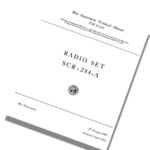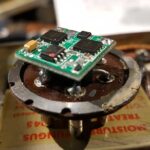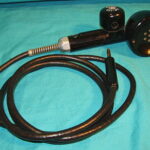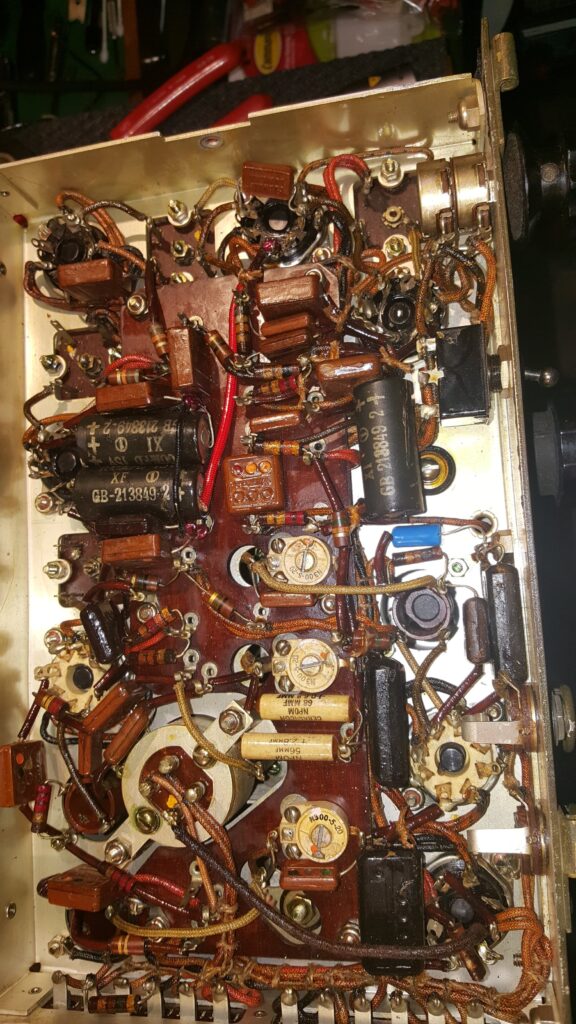RADIO SET SCR-284
THE SCR-284 BC-654 RADIO SET
A brief history
The Crosley Corporation of Cincinnati, Ohio manufactured the Signal Corps Radio set SCR-284 that consisted of the BC-654 and associated support equipment.
The SCR-284 was introduced in Africa during Operation Torch and was the first radio set used for communications from the beach to the U.S. Fleet to coordinate naval gunfire and beach radio networks.
More than 50,000 SCR-284’s were produced and delivered in support of Operation Overlord, the D-Day invasion of Normandy. The complete SCR-284 transmitter, receiver, power unit, and accessories weighed more than 100 pounds but could be divided into sections for transport. The 45 pound BC-654 transmitter was notably difficult for radiomen to carry during combat, and has been described as “roughly the weight, size and shape of a modern window air conditioner”.
Over 150,000 units were eventually produced in total. After the war, many BC-654s were sold as surplus.
1-2018
For a long, long time, I have been searching for an SCR-284 Radio Receiver and Transmitter set to add to my collection. In January of 2018, I found a set in Missouri. An Untested Early Model by Crosley Co. Serial 3339, I took a gamble and picked up the UNTESTED radio and a few other WWII radios (a BC-348, BC-312, and two BC-603’s) and items that were included in the sale. The radio came complete with legs, headphones, T-17 Microphones (2) the Power Unit PE-103-A, cables, and all the antenna sections for the 25′ mast. My wife and I made a weekend of picking it up and drove to Kansas City to pick it all up. I’ll admit, I was itching to tear into it and explore the 70+ year old technology. But I waited, and hauled it all into to my ‘war room’ and set to taking it out of the case and checking things out before I fired it up.
First I got the PE-103-A up on the bench and opened up the dynamotor. I cleaned out the bearings, repacked them with new grease, spun the armature by hand, and sealed the dynamotor back up, then I open up the compartment under the dynamotor and did a visual check of all the components, closed ti all up and hooked up the cables to a 12volt deep cycle battery. (and I double-checked to make sure I had the voltage switch set to twelve volts (it can run on either 12v or 6v power, or from a hand-cranked generator Gn-45). It came right on and put out the required voltages for operating the radio set. (yes!!)
The second step was removing the radio chassis from the aluminum cabinet (refinishing the cabinet is later in the article). Inside, the radio is spotless, with all the extra tubes, bulbs, etc. all in place. The design of the radio allows the receiver portion of the radio to swing forward away from the transmitter section to allow servicing. The Power unit inside the radio a PE-104-A has a vibrator inside to control the voltages needed by the radio set, and often the vibrator contacts are faulty. I decided to connect the cables, verifying first that the PE-104-A was set to 12 volts. I hooked up a 10′ section of wire to the antenna and crossed my fingers.
BOOM! (No, Just kidding!!) I switched the radio to VOICE operation and instantly was rewarded with static (music to my ears). The SCR-284 has a Frequency Range: continuous, 3800 to 5800 kHz so there isn’t really a lot to hear (some amateur bands, clock signals, and few other stations if you have a good antenna (I did not)). I started tuning the radio receiver with the headset on, and then, just at the upper limit of the receiver I picked up a shortwave station out of Miami Florida! I was pretty Happy!
Now, knowing the receiver section was working, I decided to test the transmitter. Using the frequency chart on the front panel of the radio, I set the frequency to 3850KC and then tuned my Grundig digital shortwave receiver to the same frequency. I keyed the mic, and sure enough, I could get a signal on the Grundig. I said a couple of test messages, and they came across, although, with a LOT of static. Will have to start replacing capacitors soon, I am sure some of them are leaky.
Set up in my ‘War Room’
Here’s a video I made of the operation on my SCR-284, hooked up to a RM-29A Remote Control Unit, and a BD-71 Telephone Switch Board, and EE-88 field telephones, and a TG-5-B Field Telegraph….whew… and it all is 100% operational.
2-2018 RESTORING THE CABINET
The inside of the SCR-284 was great, but the outside of the case was in pretty bad shape and had been repainted in flat OD a couple of times, so I decided to try refinishing it to match the wrinkle finish on the front panel and inside the case that was in decent shape. Just wanted to share what I did to complete the project.
Materials
2 Quarts Klean-Strip Premium Stripper
1 Quart Mineral Spirits
1 Quart Klean-Strip After Wash
2 Aerosol Cans VHT Black Wrinkle Paint
2 Aerosol Cans AJP(Army Jeep Parts)-WWII SEMI-GLOSS Rattle Can
2 Dozen Steel Wool Pads, toothpicks, nylon bristle brush.
STRIPPING THE CABINET First I removed the Radio Set from the case, removed the canvas straps (involved cutting stitching) Removed all data plates, Frequency charts etc.
Second I started the stripping process. This took some time, the first layers of paint came off pretty easy. I would pour on the stripper, which is like a thick gel, spread it around one side at a time, and get it onto all the brackets, loops etc. Let it sit for about 10-15 minutes then scrape off the softened paint with a plastic scraper, then switch to a steel wool pad, soaked in the stripper. (WEAR GLOVES) If you get a drop on you, you can feel the burn! Scrubbing with the steel wool pad took the paint down through the multiple layers of OD, then through the baked-on original wrinkle finish, and down to bare aluminum.
This took hours to strip. I brought it to a sandblast place and they recommended not doing it because the heat generated from the blasting could warp the case and it would roughen the aluminum unevenly. Getting all the residue from the softened paint and stripper out from inside the latches D-rings, hinge, was a chore, use bamboo skewers and toothpick and compressed air.
After all the outside sections were stripped (I didn’t do inside as all the schematics were affixed and the finish was good) I used the Klean strip after wash and miner spirits to wipe down and thoroughly reclean the stripped surfaces.
Applying the VHT Wrinkle Paint
I tried the lid to the SCR radio set first, figuring if I screw it up, it would be the easiest to re-strip, good thing too. I used Rust-Oleum® Professional Aluminum Primer (Bad Idea) after the primer dried I sprayed the VHT Wrinkle Finish on, following the directions, diagonally, back and forth, then reverse diagonally. Since I wanted the wrinkles to be tight like the original, I heated the area painted with a heat gun. You have to be patient, once it starts to wrinkle you keep applying heat in an ever greater circle, you’ll see the wrinkles spread outward. The wrinkles were way too large, so I tried the other side without the primer first (remember I had scuffed all surfaces up pretty good while stripping with steel wool). The side without the primer took the VHT well and the wrinkles were a near-perfect match to the original finish.
So, I re-stripped the bad side and refinished it with VHT, and did the same to the large cabinet, I found it worked better to do one side at a time rather than the whole thing at once, really turned out well.
Then I let it all sit for three days. then I stuck it inside my oven set at 200 for an hour and a half (yes this is even after it hit it with a heat gun while painting) Stunk up the kitchen A LOT, had to run a box fan out the window to get the stink out (dropped the kitchen temp to about 40!)
Applying the AJP Semi-Gloss OD Paint
This was tricky, I experimented on the sets J-48-A telegraph key cover. I found if you apply too much paint too closely you tend to smooth out the wrinkle look by filling the wrinkled areas with paint. So I hung all the parts from a wire from the ceiling and shot them with multiple light coats of the OD Green Semi-Gloss. This worked best and kept the wrinkle finish nice and wrinkly. I let it all dry for another three days as well. While all that was drying I spent the time cleaning the data plates and screws, rubber pieces, and making a new cover to replace the yellowed frequency chart.
So here is the finished result, the color is spot on, and the wrinkle finish is very close to the original.

Download a copy of SCR-284 Manual TM_11-275_1944.pdf
A must-have reference for the operation and repair of the radio.
3-2018 REPLACING CAPACITORS-

Ok, FIRST OFF- I am a total amateur at this. So if you’re reading this, and looking for help, I’ll gladly offer up what I can, but I am not an expert (I figure if an 18-year-old kid could work on these radios in WWII, someone in his fifth decade should have a reasonable shot at doing the same). I took some training from an older gentleman, who offers his expertise to newbies like me. As my practice radio, I bought a 1943 Philco AM radio and took a 7-hour crash course in rebuilding antique radios. Surprise!, it worked after replacing all the caps and a couple of resistors, and a new volume pot. So then with my newfound, but limited knowledge, I ordered a capacitor kit that has many various and assorted capacitors to replace the black Micamold Brand paper capacitors and also ordered specific capacitors (electrolytics) for the BC-654.
Here is a bit of advice:
- Use the schematic and the parts list in the manual to double and triple check the capacitor values and locations!
- Do ONE capacitor at a time, just ONE! If you clip out the old one and don’t replace it immediately, mark the connections with tape, it’s easy to walk away and get a cup of coffee, only to come back and find it looks different than when you left. Make a mechanical connection form the old wire on the radio set, to the new capacitor. (I use a simple ‘J’ bend in the wire on both ends, crimped tight, then solder the connection).
- Use spaghetti tubing on the new caps to prevent any shorts, as the replacements are smaller and take up less space than the originals
- I have seen restorations where the restorer restuffed new caps into the old Micamold body. WOW, dedication and time-consuming. Here’s a link to a discussion on that http://antiqueradios.com/forums/viewtopic.php?f=6&t=197257view
- Move on to the next capacitor, Verify, and do ONE at a time.
- Have fun, relax, and solder ahead.
After replacing the capacitors in the receiver, the sensitivity of signals received went up considerably. I have yet to replace capacitors in the transmitter section, I’ll wait on that till I have the repairs done to the PE-104 Power Supply.
PE-104-A
My next challenge is the replacement of the capacitors in the PE-104-A Power supply. The PE-104 is packed with capacitors and frankly, I haven’t replaced any of them, except one, the easiest one to get to; Capacitor 4-C-1. A .2uF 100v capacitor in a metal brass tube. Even this was a tough one to get out, it has an attached tab that screws into the chassis, and the area was so packed with the original wiring, I couldn’t get to the screw, so it cut through the bracket with my Dremel tool and removed it. You can see in the picture, that the new yellow capacitor is much smaller than the original sitting on the power unit above it. Somehow I need to figure out how to access the capacitors on the other side, as some are hash filters, and seem to be bad, as I am getting to much noise from the PE-103 power supply. I did replace the original rectifier with a new version using a VH448 silicone rectifier. At least the old one came out easily and the new one went in well.
Next step for the PE-104-A Power supply is to convert the VS-3 Vibrator unit to solid-state. My original one works, so I’ll set that aside and ‘operate’ on a sacrificial one as a test subject. I have enlisted some major help in figuring out the circuit here and will hold off on posting any of my work, schematics, parts, etc. and credits till I have a working solution.
3/15/2018
New Old Stock VS-3 vibrator Showed up! Too nice to use as my one to cut up, so will get another. I searched for and found NOS (New Old Stock) replacements. I think it’s pretty cool that when these were boxed up in May of 1945, and that the words “Do Not Open Until Ready For Use” printed on the box- that they had no idea it would be not opened for 73 years and 2 months! So here’s the unboxing of my brand new 73-year-old parts! Thank you to the Arsenal Of Democracy! Of course, by now we should all have flying cars…
VS-3 Conversion
CONVERTING THE VIBRATOR IN THE PE-104-A TO SOLID STATE USING A MODERN VBP-1 MODULE.

This became a larger project and I did a write up of it since it was so long, I decided to make a page just detailing the conversion. You can find it and a PDF download of the instructions and schematic by clicking here: VS-3 Vibrator Conversion
If you want to try and get your vibrator working WITHOUT the solid-state conversion, you could try this:
The best way to clean the points is to cut some copier paper into 1/2 inch strips. (I also heard a crisp dollar bill works or a white business card) You will need at least 4 strips. Insert strip between points, saturate strip and points with carburetor cleaner and pull strip back and forth while holding points together with just enough force to pull strip thru. When the strip starts to dry out, points will start to squeak or squeal and you will see gunk on the paper strip. Repeat this procedure at least once more. There were times I had to repeat four or five times to get points to make contact. This procedure works great on new contacts, but if they are pitted, the rough points pull paper fibers out and cause additional problems.
If points need adjusting, the gap is fairly critical and hard to make. About .003 or .004 for primary, and .004 or .005 for secondary.
“MODERNIZING” THE T-17 MICROPHONE FOR INCREASED SENSITIVITY.
I noticed that one of my T-17 mics allows better voice transmission than the other one, still, I basically have to yell into it to get a clear transmission. Conversely, when I have it set up using the RM-29-A Remote Control, with the telephone handset, the voice is much clearer. So I did a bit of searching and found this short article on “Modernizing” the T-17 from 1958. It suggests using a T-1 or F-1 telephone element to replace the original. I am going to give it a shot on one of my mics and see how it goes. I will try the T-1 element as it is a bit smaller than the F-1 and doesn’t require too much modification.
I got a NOS T-1 transmitter and a smaller N-1 Transmitter from http://phonesurplus.com/ Steve Hilz (I highly recommend him). The N-1 is about an inch and a quarter across, much smaller than the original transmitter, and the T-1 is just a hair too big. I decided the use the T-1 Transmitter. First I had to drill out the bakelite filler in the mouthpiece to access the screws to disassemble the cover from the mic base. Then used my Dremel tool with a coarse sanding drum attachment to enlarge the mic base to accept the new transmitter. I put a small groove inside on the side to alow me to get a point tool in there in case I ever wanted to pop the transmitter out. I abraded the contacts with a Scotch-Brite pad for better solder contact and soldered the leads to the new carbon transmitter. Then using the original spacer placed the completed swap into the mic handle. I did drill 6 new holes into the mouthpiece. Screwed it all together and buffed it out. The sound quality on transmit is much better and much clearer now.














